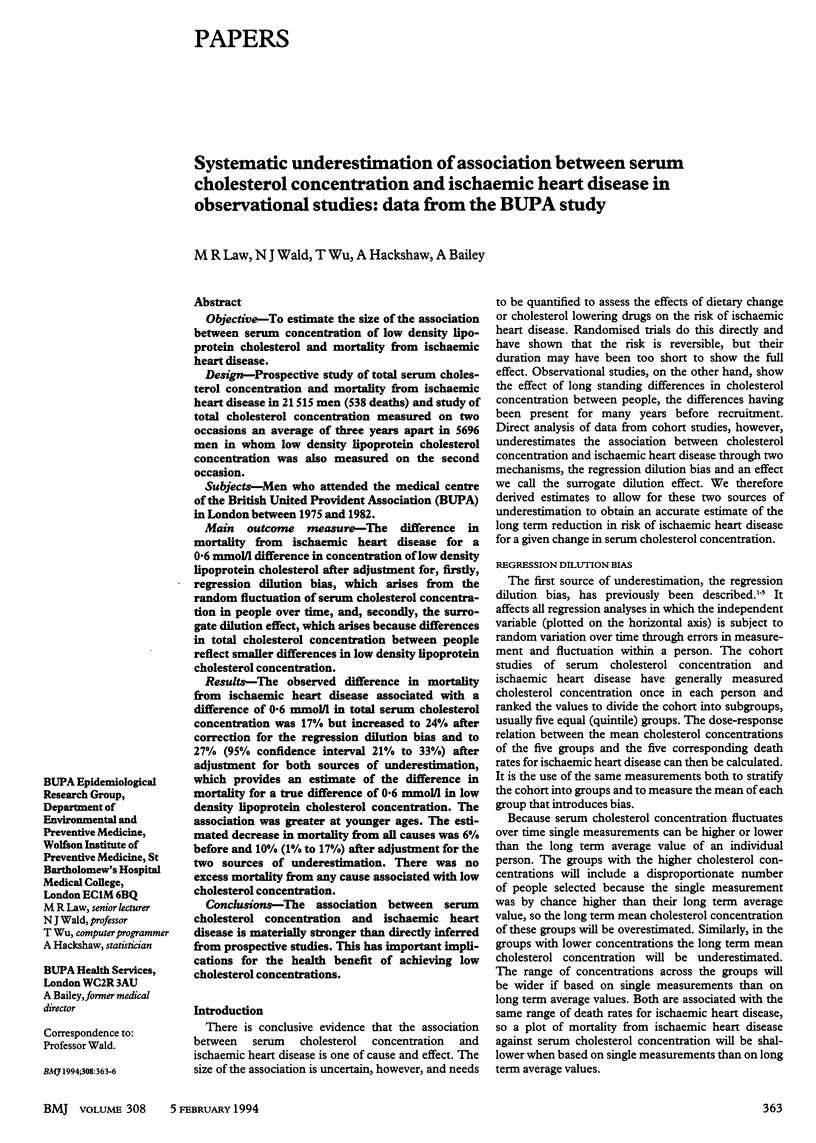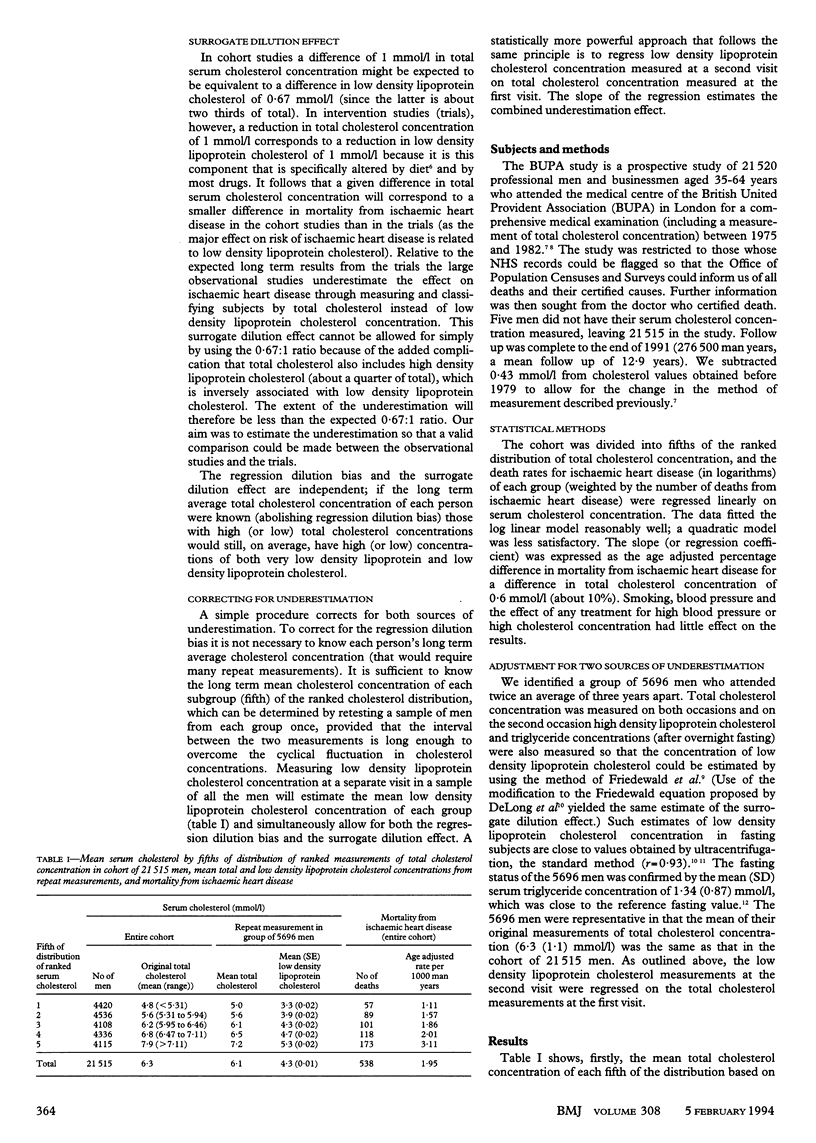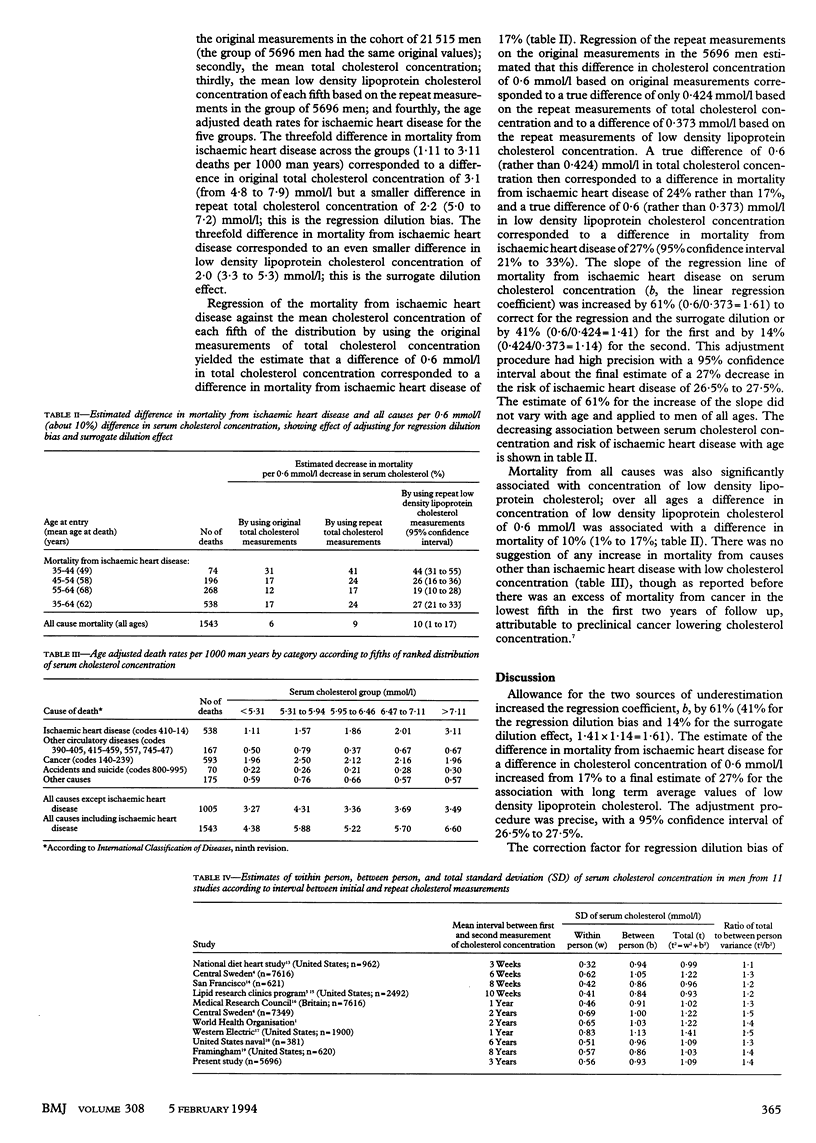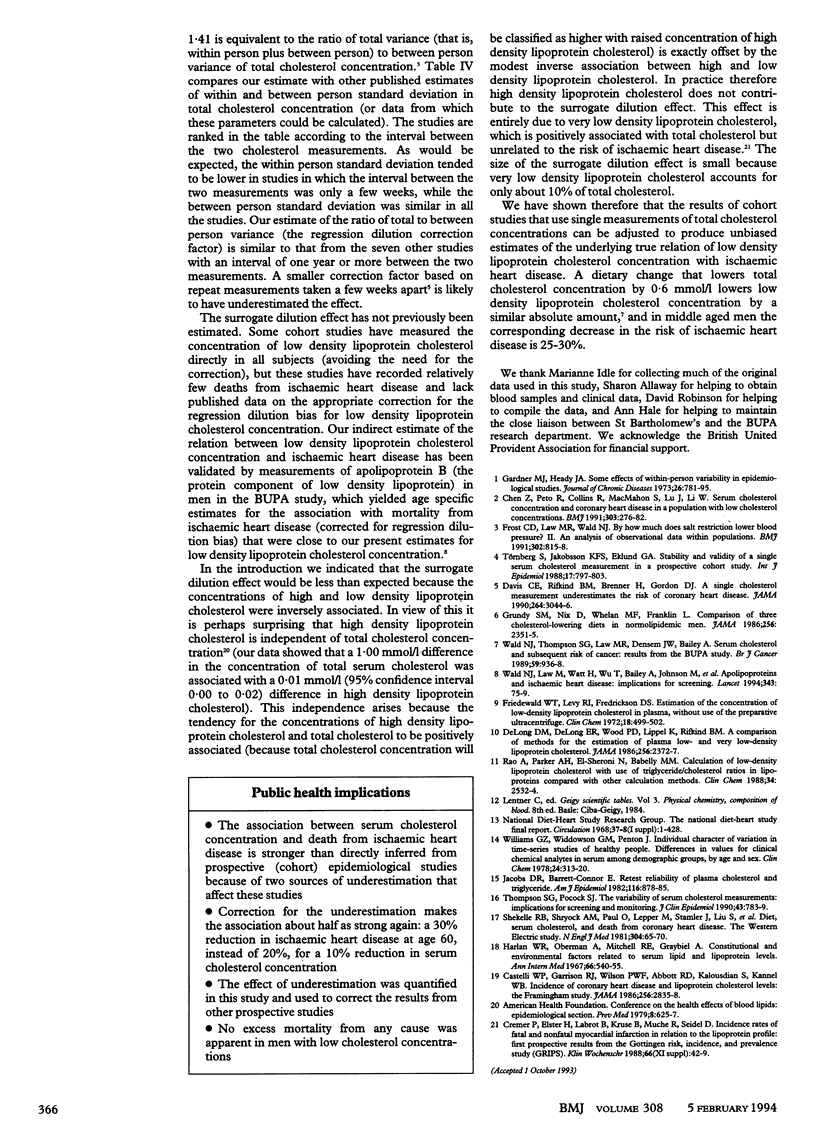Abstract
OBJECTIVE--To estimate the size of the association between serum concentration of low density lipoprotein cholesterol and mortality from ischaemic heart disease. DESIGN--Prospective study of total serum cholesterol concentration and mortality from ischaemic heart disease in 21,515 men (538 deaths) and study of total cholesterol concentration measured on two occasions an average of three years apart in 5696 men in whom low density lipoprotein cholesterol concentration was also measured on the second occasion. SUBJECTS--Men who attended the medical centre of the British United Provident Association (BUPA) in London between 1975 and 1982. MAIN OUTCOME MEASURE--The difference in mortality from ischaemic heart disease for a 0.6 mmol/l difference in concentration of low density lipoprotein cholesterol after adjustment for, firstly, regression dilution bias, which arises from the random fluctuation of serum cholesterol concentration in people over time, and, secondly, the surrogate dilution effect, which arises because differences in total cholesterol concentration between people reflect smaller differences in low density lipoprotein cholesterol concentration. RESULTS--The observed difference in mortality from ischaemic heart disease associated with a difference of 0.6 mmol/l in total serum cholesterol concentration was 17% but increased to 24% after correction for the regression dilution bias and to 27% (95% confidence interval 21% to 33%) after adjustment for both sources of underestimation, which provides an estimate of the difference in mortality for a true difference of 0.6 mmol/l in low density lipoprotein cholesterol concentration. The association was greater at younger ages. The estimated decrease in mortality from all causes was 6% before and 10% (1% to 17%) after adjustment for the two sources of underestimation. There was no excess mortality from any cause associated with low cholesterol concentration. CONCLUSIONS--The association between serum cholesterol concentration and ischaemic heart disease is materially stronger than directly inferred from prospective studies. This has important implications for the health benefit of achieving low cholesterol concentrations.
Full text
PDF



Selected References
These references are in PubMed. This may not be the complete list of references from this article.
- Castelli W. P., Garrison R. J., Wilson P. W., Abbott R. D., Kalousdian S., Kannel W. B. Incidence of coronary heart disease and lipoprotein cholesterol levels. The Framingham Study. JAMA. 1986 Nov 28;256(20):2835–2838. [PubMed] [Google Scholar]
- Chen Z., Peto R., Collins R., MacMahon S., Lu J., Li W. Serum cholesterol concentration and coronary heart disease in population with low cholesterol concentrations. BMJ. 1991 Aug 3;303(6797):276–282. doi: 10.1136/bmj.303.6797.276. [DOI] [PMC free article] [PubMed] [Google Scholar]
- Cremer P., Elster H., Labrot B., Kruse B., Muche R., Seidel D. Incidence rates of fatal and nonfatal myocardial infarction in relation to the lipoprotein profile: first prospective results from the Göttingen Risk, Incidence, and Prevalence Study (GRIPS). Klin Wochenschr. 1988;66 (Suppl 11):42–49. [PubMed] [Google Scholar]
- Davis C. E., Rifkind B. M., Brenner H., Gordon D. J. A single cholesterol measurement underestimates the risk of coronary heart disease. An empirical example from the Lipid Research Clinics Mortality Follow-up Study. JAMA. 1990 Dec 19;264(23):3044–3046. [PubMed] [Google Scholar]
- DeLong D. M., DeLong E. R., Wood P. D., Lippel K., Rifkind B. M. A comparison of methods for the estimation of plasma low- and very low-density lipoprotein cholesterol. The Lipid Research Clinics Prevalence Study. JAMA. 1986 Nov 7;256(17):2372–2377. [PubMed] [Google Scholar]
- Friedewald W. T., Levy R. I., Fredrickson D. S. Estimation of the concentration of low-density lipoprotein cholesterol in plasma, without use of the preparative ultracentrifuge. Clin Chem. 1972 Jun;18(6):499–502. [PubMed] [Google Scholar]
- Frost C. D., Law M. R., Wald N. J. By how much does dietary salt reduction lower blood pressure? II--Analysis of observational data within populations. BMJ. 1991 Apr 6;302(6780):815–818. doi: 10.1136/bmj.302.6780.815. [DOI] [PMC free article] [PubMed] [Google Scholar]
- Grundy S. M., Nix D., Whelan M. F., Franklin L. Comparison of three cholesterol-lowering diets in normolipidemic men. JAMA. 1986 Nov 7;256(17):2351–2355. [PubMed] [Google Scholar]
- Harlan W. R., Jr, Oberman A., Mitchell R. E., Graybiel A. Constitutional and environmental factors related to serum lipid and lipoprotein levels. Ann Intern Med. 1967 Mar;66(3):540–555. doi: 10.7326/0003-4819-66-3-540. [DOI] [PubMed] [Google Scholar]
- Jacobs D. R., Jr, Barrett-Connor E. Retest reliability of plasma cholesterol and triglyceride. The Lipid Research Clinics Prevalence Study. Am J Epidemiol. 1982 Dec;116(6):878–885. doi: 10.1093/oxfordjournals.aje.a113490. [DOI] [PubMed] [Google Scholar]
- Rao A., Parker A. H., el-Sheroni N. A., Babelly M. M. Calculation of low-density lipoprotein cholesterol with use of triglyceride/cholesterol ratios in lipoproteins compared with other calculation methods. Clin Chem. 1988 Dec;34(12):2532–2534. [PubMed] [Google Scholar]
- Shekelle R. B., Shryock A. M., Paul O., Lepper M., Stamler J., Liu S., Raynor W. J., Jr Diet, serum cholesterol, and death from coronary heart disease. The Western Electric study. N Engl J Med. 1981 Jan 8;304(2):65–70. doi: 10.1056/NEJM198101083040201. [DOI] [PubMed] [Google Scholar]
- Thompson S. G., Pocock S. J. The variability of serum cholesterol measurements: implications for screening and monitoring. J Clin Epidemiol. 1990;43(8):783–789. doi: 10.1016/0895-4356(90)90238-k. [DOI] [PubMed] [Google Scholar]
- Törnberg S. A., Jakobsson K. F., Eklund G. A. Stability and validity of a single serum cholesterol measurement in a prospective cohort study. Int J Epidemiol. 1988 Dec;17(4):797–803. doi: 10.1093/ije/17.4.797. [DOI] [PubMed] [Google Scholar]
- Wald N. J., Law M., Watt H. C., Wu T., Bailey A., Johnson A. M., Craig W. Y., Ledue T. B., Haddow J. E. Apolipoproteins and ischaemic heart disease: implications for screening. Lancet. 1994 Jan 8;343(8889):75–79. doi: 10.1016/s0140-6736(94)90814-1. [DOI] [PubMed] [Google Scholar]
- Wald N. J., Thompson S. G., Law M. R., Densem J. W., Bailey A. Serum cholesterol and subsequent risk of cancer: results from the BUPA study. Br J Cancer. 1989 Jun;59(6):936–938. doi: 10.1038/bjc.1989.198. [DOI] [PMC free article] [PubMed] [Google Scholar]
- Williams G. Z., Widdowson G. M., Penton J. Individual character of variation in time-series studies of healthy people: II. Differences in values for clinical chemical analytes in serum among demographic groups, by age and sex. Clin Chem. 1978 Feb;24(2):313–320. [PubMed] [Google Scholar]


